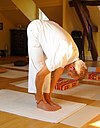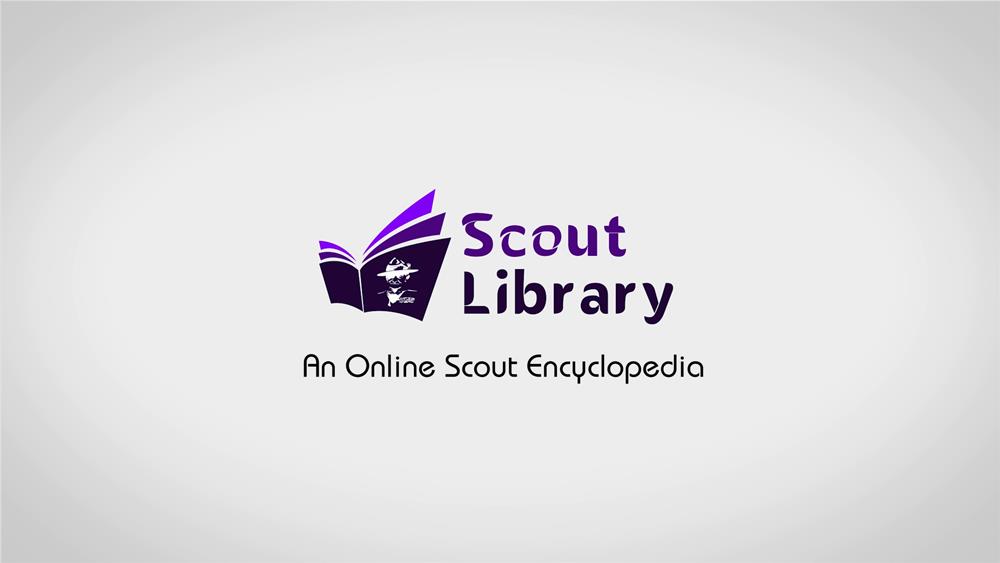Surya Namaskara also known in English as Sun Salutation (lit. "salute to the sun") is a common sequence of asanas. Its origins lie in India where its large Hindu population worships Surya, the Hindu solar deity. This sequence of movements and asanas can be practised on varying levels of awareness, ranging from that of physical exercise in various styles, to a complete sadhana which incorporates asana, pranayama, mantra and chakra meditation. It is often the beginningvinyasa within a longer yoga series. SÅ«rya NamaskÄra may also refer to other styles of "Salutations to the Sun".
Ancient
The Hatha Yoga Pradipika, the oldest known hatha yoga text does not mention "Sun Salutations" but mentions a sÅ«rya-bhedana (sun-piercing) kumbhaka (II, 44 and 48-50) while the Gheraṇá¸a Saá¹hitÄ mentions sÅ«rya-bheda kumbhaka (58-59). The oldest documented book with clear depictions of asanas is the Sritattvanidhi, though there is no mention of "Sun Salutations" in the text, it does describe the asanas "Sarpasana" (Bhujangasana), "Gajasana" (Adhomukh Swannasan), "Uttanasana" and series of asanas done in tandem, similar to SÅ«rya NamaskÄra.
Mysore
Incidentally the translator of the ancient Sritattvanidhi., Krishnaraja Wodeyar III, was also responsible for arranging for Sri. T. Krishnamacharya to teach yoga at YogaÅ›ÄlÄ in Mysore sometime around 1930. Sri. T. Krishnamacharya's teachings are largely responsible for the modern version of SÅ«rya NamaskÄra as seen in modern day Ashtanga Vinyasa Yoga and the Visesha Vinyasa Sun Salutation subroutine from Vinyasa Krama Yoga, as well as a host of other popular forms of yoga. K. Pattabhi Jois claims to have taught exactly as he had learned from Krishnamacharya, though other than personal testimony, there seems to be no other evidence as to the precise content of Krishnamacharya's teachings. While Krishnamacharya's specific sources for his yoga teachings are unclear, it is said that he learned from Sri Ramamohana Brahmachari in the Himilayan Mountains (perhaps Muktinath where his son has visited , but certainly somewhere near the Gandaki River in Nepal) beginning in 1916; however, the source of his teaching (at the Mysore Yogashala or otherwise) is not otherwise documented. Krishnamacharya's son attests to his father having developed some of his teachings himself. There is the possibility that he may have been influenced by the Mysore Palace Gymnastics Tradition.
Raja of Aundh
Another indication as to the origins of SÅ«rya NamaskÄra is the 1928 Indian publication of "The Ten Point Way of Health" by Raja Bhavan Rao Srinivas ("Bala Sahib"), Pant Pratinidhi of Aundh (1868–1951; Raja of Aundh 1909-1947), followed by later publication in England in 1938. The Raja claims to have practiced the series as a child. And some sources report that only after extensive practice and analysis (and potentially modification) himself did he finally publish the book. Thus, the true origin of the series remains unclear, though it has to be noted that Raja of Aundh, himself never claimed to have invented Surya Namaskar. Further he actually stressed on the ancient origins of this procedure. He helped in popularizing surya namaskar as a simple physical exercise for all round development of an individual in India. He introduced it in schools as a form of education and encouraged even the ordinary man to be physically fit by performing surya namaskar every day. Still, how exactly SÅ«rya NamaskÄra came to be included in the yogic practices of Hatha and Ashtanga Yoga remains unclear.
Series
| Step | Asana | Breath | Images | Chakra | Position | BÄ«ja | |
|---|---|---|---|---|---|---|---|
| Sanskrit | Transliteration | ||||||
| 1 | Pranamasana | exhale |  |
Anahata | Heart | ॠहà¥à¤°à¤¾à¤‚ | om hrÄá¹ |
| 2 | Hasta Uttanasana | inhale |  |
Vishuddhi | Throat | ॠहà¥à¤°à¥€à¤‚ | om hrÄ«á¹ |
| 3 | Hastapaadasana | exhale |  |
Swadhisthana | Sacrum | ॠहà¥à¤°à¥‚ं | om hrÅ«á¹ |
| 4 | Aekpaadprasarnaasana (one foot back, lift head, hands often on earth ) | inhale |  |
Ajna | Third eye | ॠहà¥à¤°à¥ˆà¤‚ | om hraiá¹ |
| 5 | Adho Mukha Svanasana / parvatasana | exhale |  |
Vishuddhi | Throat | ॠहà¥à¤°à¥Œà¤‚ | om hrauá¹ |
| 6 | Ashtanga Namaskara | suspend |  |
Manipura | Solar plexus | ॠहà¥à¤°à¤ƒ | om hraḥ |
| 7 | Bhujangasana | inhale |  |
Swadhisthana | Sacrum | ॠहà¥à¤°à¤¾à¤‚ | om hrÄá¹ |
| 8 | Adho Mukha Svanasana | exhale |  |
Vishuddhi | Throat | ॠहà¥à¤°à¥€à¤‚ | om hrÄ«á¹ |
| 9 | Ashwa Sanchalanasana (opposite foot forward from 4, hands often on earth ) | inhale |  |
Ajna | Third eye | ॠहà¥à¤°à¥‚ं | om hrÅ«á¹ |
| 10 | Uttanasana | exhale |  |
Swadhisthana | Sacrum | ॠहà¥à¤°à¥ˆà¤‚ | om hraiá¹ |
| 11 | Hasta Uttanasana | inhale |  |
Vishuddhi | Throat | ॠहà¥à¤°à¥Œà¤‚ | om hrauá¹ |
| 12 | Pranamasana | exhale |  |
Anahata | Heart | ॠहà¥à¤°à¤ƒ | om hraḥ |
Mantras
2 Surya Namasakras are practised per cycle.
In the table, the following first 12 mantras corresponds to the 12 asanas in Surya Namasakara and can also be chanted or repeated mentally during the performance of each corresponding asana. They can also be pronounced at Pranamasana.
| Salutation | Sanskrit | Transliteration |
|---|---|---|
| 1 | ॠमितà¥à¤°à¤¾à¤¯ नमः | om mitrÄya namaḥ |
| 2 | ॠरवये नमः | om ravaye namaḥ |
| 3 | ॠसूरà¥à¤¯à¤¾à¤¯ नमः | om sÅ«ryÄya namaḥ |
| 4 | ॠà¤à¤¾à¤¨à¤µà¥‡ नमः | om bhÄnave namaḥ |
| 5 | ॠखगाय नमः | om khagÄya namaḥ |
| 6 | ॠपूषà¥à¤£à¥‡ नमः | om pūṣṇe namaḥ |
| 7 | ॠहिरणà¥à¤¯à¤—रà¥à¤à¤¾à¤¯ नमः | om hiraṇya garbhÄya namaḥ |
| 8 | ॠमरीचये नमः | om marīcaye namaḥ |
| 9 | ॠआदितà¥à¤¯à¤¾à¤¯ नमः | om ÄdityÄya namaḥ |
| 10 | ॠसवितà¥à¤°à¥‡ नमः | om savitre namaḥ |
| 11 | ॠअरà¥à¤•à¤¾à¤¯ नमः | om arkÄya namaḥ |
| 12 | ॠà¤à¤¾à¤¸à¥à¤•à¤°à¤¾à¤¯ नमः | om bhÄskarÄya namaḥ |
| 13 | ॠशà¥à¤°à¥€à¤¸à¤µà¤¿à¤¤à¥ƒà¤¸à¥‚रà¥à¤¯à¤¨à¤¾à¤°à¤¾à¤¯à¤£à¤¾à¤¯ नमः | om Å›rÄ«savitá¹›sÅ«ryanÄrÄyaṇÄya namaḥ |



